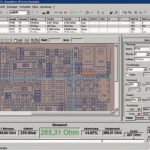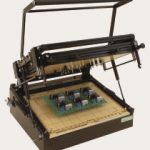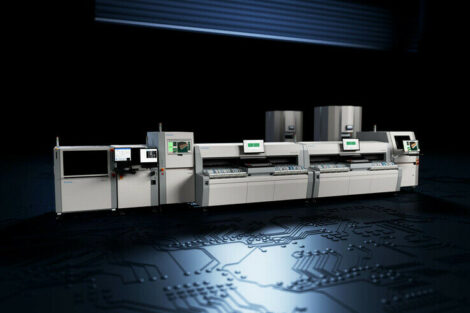An affordable and economic board test system should meet different requirements: low investment cost, high performance in speed, accuracy and a variety of test methods, and has to be very reliable, too. And a minimum of costs for fixturing and programming for in-circuit and functional tests will allow verifying even upcoming products at a fraction of costs.
Peter Reinhardt, Reinhardt System- und Messelectronic GmbH
Everyone in test business knows that loaded electronic boards reveal an enormous amount of faults, collected during the process of production. The typical defect rate depends on the size of a board assembly, on technology, on density and, of course, on the experience of the design engineer. As long as human beings work in the process of assembling boards, we must live with their strengths, but also with their weaknesses. The defect rate is between 2 and 40% so that a 100% test of all boards is an absolute necessity. Typical fault created during the different assembly process steps are the application of wrong components reels and ESD-defects of CMOS devices. But in most cases (more than 60%), the huge problems are soldering defects that are created by serious layout and PCB flaws. And not to be forgotten: the manufacturing re-sult also depends heavily on the expertise of the person(s) who design, evaluate and supervise the soldering process itself, and the support they have gained by suppliers of paste printer, the paste, the oven or even the printer stencil. This can, by the way, be a very complex situation. We also fight problems with semiconductor devices which used to crack because, due to inappropriate storage, their package contained too much humidity. Therefore, we experience components insufficiently soldered, cracking, standing-up (tombstoning or billboarding), or moving from placement position, and all these will cause numerous manufacturing-related defects.
There are different methods for the verification of board assemblies. As all specialists probably know, functional test is the historical procedure of quality proof. For about 30 years, the in-circuit test (ICT) has been serving for localization of production-based defects, and now the automated optical inspection (AOI) rounds up these processes. We can assume that the functional test covers at best 90% of all possible faults. The ICT, depending on how well the circuitry on a board can be connected in applying this method, might cover up to 95% of all electronic components, and the optical inspection, depending on the equipment or operators, respectively, lies between 35 and 50%. If we add-up these three methods, the result is certainly not 235%, but can reach maximum fault coverage of up to 96 or 97% – not more. From time to time, enthusiastic sales people talk about a figure of 99.5% – just a daydream, not a realistic value on the shop floor. However, 96 to 97% seems to be a realistic figure that can be attained with some effort.
Many of our customers (manufacturer of board assemblies) frequently ask what kind of test method is the best, which brings the finest results in quality verification and assurance, and which method they eventually should use? To be honest and serious in business, the preferred procedure must be a combination of these three methods mentioned.
In 37 years of work in this field and with very close contact to manufacturers of board assemblies in Europe, we have learned that virtually 30% of these companies do not test at all. Another group of 30% at least have them visually inspected by operators in the production line. Another 28% do more or less a poor functional test, and only 12% verify their board seriously, and have very few surprises and service/rework returns from their customers. A very common excuse is that board test is much too expensive and that small-sized firms cannot afford it.
The amalgamation of Europe has good and bad aspects, and one of them is product liability. This means, if an endproduct fails and man or values are damaged, the solicitors will very quickly find out who is responsible. Moreover, if, for example, the electronics in this product has not properly tested and there is no documentation available about this functional verification, the selling company is simply liable for all the costs. Therefore, electronics must be tested very carefully, if a manufacturer does not want to run the danger of being caught.
Different and parallel test departments
About 30 years ago, the in-circuit test took over a large portion of the fault-coverage verification of board assemblies, and over time, this test area developed its own infrastructure. Moreover, the same infrastructure has developed for functional tests, so that there eventually were two complete test infrastructures in two different departments. As communication was not good between in-circuit and functional test areas, the costs very soon boiled over and were out of control.
Over the many years in the business, we have learned from the manufacturers of board assemblies that the test cost allowance is a maximum of 10% of the board value plus labor. Anything above is painful and tends to avoid testing.
Paying too much for the wrong system
We have learned that 77% of electronic manufacturers in Europe have varieties of 50 to 500 different board types. Quantities are between 3 and 5,000 units, and typical production lots are between 200 and 400.
The board test systems, which have been used for the last 30 years, were designed for quantities of 100,000 to 500,000 units, but such jobs can only be found in about 250 companies in Europe. Using such a test system for smaller batches means: with quantities of 200 to 400 boards the costs will be about 50 to 100% of the value of the device under test (DUT). Such costs are much too high, because they mean there is no profit margin left, it’s completely gone. Our test systems, which have been available for more than 20 years, cause investment costs of a third or a fifth, and require no engineers or software specialists to be operating on the shop floor. In fact, skilled workers or technicians program 70% of our test systems in the field, respectively. The powerful machine software contains a wealth of practical knowledge from the test floor, and allows finalizing a typical programming task within 3 to 5 hours for in-circuit test. This are a mere tenth of the time it used to take if skilled workers programmed and debugged. Therefore, the costs of ownership (COO) or charges for product verification are remarkably lower.
Combinational in-circuit and functional test
We have learned that in many large firms, there are two more or less separate test departments, and their complete infrastructures create a lot more costs as if the final tests (in-circuit and functional), are provided with one test fixture and in one run. The test fixtures which are required for our test systems have been developed in a way that the individual solution for each board costs typically 400 to 500 euro. This too is a tenth of the expenses which have been typical for large systems. An automated fixture-designing system is commercially available for our customers. It allows drilling the bed-of-nails panel and setting the pin positions in a very short time. The test pins are connected via wire wrap, so that the fixture is set-up semi-automatically. In our experience, this takes about 3 to 5 hours for a fixture with 400 test pins. The costs we have mentioned here are based on our customers‘ information, therefore, they are realistic figures. Programming the in-circuit test (manufacturing defects analyzer, MDA) takes another 3 to 5 hours. In addition, the preparation of the functional test, depending on the technology that is used, requires 1 or 2 days of programming and debugging work.
Time-to-market
Practically all board assemblers have gained painstaking experience with time-to-market constraints. This is especially true in the computer industry. We have seen manufacturers which spent 2 to 3 months for fixturing and programming a single board with the other kind of testers. We think this is a lethal situation for an assembler, because computer boards (with identical or higher performance) dramatically drop their market value within two months from 1,000 euro, for example, down to about 50 euro. Keeping this in mind, the solution we offer with our automated fixture designing system will not only pay for itself with building three of those fixtures, but it will keep customers competitive in their business, also on a leading-edge position.
AOI and its results
With optical inspection methods, AOI systems have been in use covering up to 40 to 45% of the possible defects, provided they are adequately programmed and ”tuned”. Nevertheless, most of these systems use their capabilities in a very limited way for inspecting resistors, capacitors, inductors and semiconductors. The most important parts such as electro-mechanical elements (connectors, relays, transformers) or other components such as large inductors and large semiconductors, are poorly or very seldom inspected. Many AOI systems do not allow inspection on components higher than 10mm, which excludes all those larger parts. The defect rate on these components is relatively high, and we recommend their inspection as an essential step of quality assurance. The inspection of solder joints is quite good in general, but not too thorough. Here, a huge amount of engineering is necessary to improve this kind of inspection.
AOI systems are still quite expensive. With fault coverage of a maximum of 40 to 45% (if electro-mechanical and large parts are inspected), there isn’t a good relationship between the investment and its outcome. Many of the inspection tasks, which an AOI system is supposed to provide, can be done by in-circuit test using sensor pins. These sensor test pins will be set to measure and verify mechanical positions, for example the location of a connector, a dual in-line IC, a transformer, etc. The pin information will be read from the system automatically during the in-circuit test and will save operators from an exhausting inspection job.
Functional test
Functional test covers at best 90% of the possible board faults. This would mean that although components are missing or wrong in value, the function of this circuit cluster would erratically be still performed. However, how stable this function will be performed under temperature changes, component aging, connecting other boards to a bus system or with mains voltage variations, is another question, and can be a bad experience. For this reason and to avoid those quality problems, in-circuit test of components is necessary, especially to assure highest functional reliability from this side.
ICT and functional test combined in one process
As already mentioned, operating two separate test departments, one for in-circuit and one for functional test, is very expensive and doubles – in fact triples – test expenses, because each department has its own infrastructure. If all test methods and optical inspection are combined on one site, a fixture can be made used for all them, and handling is only needed once. The time between inspection, in-circuit and functional test is only seconds and the fault coverage reaches up to nearly 97%. This is the solution board assemblers need now, and by using the right equipment, they can definitely save costs.
Such a universally applicable fixture should include the spring-loaded pins for in-circuit test (MDA), the sensor pins for sensing missing or rotated components and connection cables, but also spring-loaded pins for the functional tests. With this kind of fixture, the costs do not exceed 600 to 700 euro, but allow performing tests that give the highest result possible. A typical procedure for the in-circuit test takes about 10s, and then we have to add another 1 or 2s for the sensor-pin test and, finally, about 30s for the functional test. This short time for functional test can only be attained if the equipment allows for this kind of higher speed.
In a nutshell: a Reinhardt board test system causes extremely low investment cost, guarantees high test performance in speed, accuracy and variety of tests, and is very reliable, too. A minimum of cost for fixturing and programming for in-circuit and functional tests as well as mechanical sensing will allow to test even upcoming products at a fraction of the costs.
ZUSAMMENFASSUNG
Die Baugruppenprüfung in der Fertigung ist grundsätzlich nötig, um konkrete Aussagen über Qualität und Zuverlässigkeit der Produkte zu erhalten, wird aber weithin als „notwendiges Übel” betrachtet. Zudem sind bei kleineren Produktionslosen oft die Testkosten in Relation zum Wert einer Baugruppe recht hoch. Abhilfe kann man mit kostengünstigen und einfach bedien- und programmierbaren Boardtestern erreichen, die In-Circuit- und Funktionsprüfung vereinen. Zudem offeriert der Anbieter auch noch ein Low-Cost-System für die rasche und preiswerte Fertigung der nötigen Test-Adaper. Dies alles dient der Zielsetzung, möglichst niedrige Testkosten in Fertigungsumgebungen zu erreichen, die man gemeinhin mit High-Mix/Low-Volume umschreibt.
RESUMÉ
Les tests dans la production de modules sont nécessaires de manière générale afin d’obtenir des données concrètes sur la qualité et la fiabilité des produits; toutefois, ces tests continuent à être considérés comme ”un mal nécessaire”. En outre, si les lots de production sont moins importants, le coût des tests est souvent élevé par rapport à la valeur du module. Il est possible de se procurer de l’aide grâce à des testeurs de plaque qui sont économiques, faciles à manipuler et à programmer. Ils allient contrôle en circuit et de fonction. En plus, le prestataire offre également un système de coût réduit pour produire rapidement et économiquement les adaptateurs de test nécessaires. Tout ceci est destiné à obtenir des coûts aussi bas que possible dans des environnements de production qui sont désignés communément par ”high-mix/low volume”.
SOMMARIO
In linea di massima sono comunque richiesti accurati controlli dei gruppi costruttivi nella produzione, per ottenere informazioni concrete sulla qualità e l’affidabilità dei prodotti, ma ciò viene tuttora considerato un ”male necessario”. Inoltre, nelle partite di produzione più piccole molto spesso i costi per i test sono piuttosto elevati in relazione al valore di un gruppo costruttivo. I Boardtester, che riuniscono le funzioni In-Circuit e di test, offrono una soluzione economica e possono inoltre essere impiegati e programmati con molta facilità. Inoltre, il produttore di questi tester offre anche un sistema Low-Cost per la produzione rapida ed economica dei necessari adattatori di test. Tutto ciò contribuisce all’obiettivo perseguito per raggiungere costi di test possibilmente bassi negli stabilimenti di produzione, che vengono comunemente definiti High-Mix/Low-Volume.
Share:













